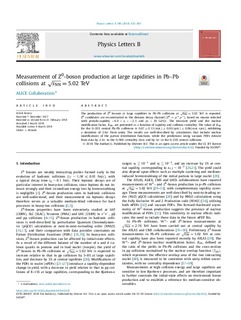Measurement of Z0-boson production at large rapidities in Pb–Pb collisions at √sNN = 5.02 TeV
Acharya, Shreyasi; Adamová, Dagmar; Adolfsson, Jonatan; Aggarwal, Madan M.; Aglieri Rinella, Gianluca; Agnello, Michelangelo; Agrawal, Nikita; Ahammed, Zubayer; Ahn, Sang Un; Aiola, Salvatore; Alme, Johan; Altenkaemper, Lucas; Djuvsland, Øystein; Fionda, Fiorella Maria Celeste; Lønne, Per-Ivar; Nystrand, Joakim; Rehman, Attiq ur; Røhrich, Dieter; Tambave, Ganesh Jagannath; Ullaland, Kjetil; Velure, Arild; Wagner, Boris; Zhang, Hui; Zhou, Zhuo; Zhu, Hongsheng; Arsene, Ionut Christian; Bätzing, Paul Christoph; Dordic, Olja; Lardeux, Antoine Xavier; Lindal, Svein; Mahmood, Sohail Musa; Richter, Matthias; Røed, Ketil; Skaali, Toralf Bernhard; Tveter, Trine Spedstad; Wikne, Jon Christopher; Zhao, Chengxin; Helstrup, Håvard; Hetland, Kristin Fanebust; Kileng, Bjarte; Nesbø, Simon Voigt; Storetvedt, Maksim Melnik; Langøy, Rune; Lien, Jørgen; Akindinov, Alexander; Al-Turany, Mohammed; Alam, Sk Noor; De Albuquerque, Danilo Silva; Aleksandrov, Dimitry; Alessandro, Bruno; ALICE, Collaboration
Journal article, Peer reviewed
Published version

View/
Date
2018Metadata
Show full item recordCollections
- Institutt for mikrosystemer [546]
- Publikasjoner fra CRIStin [3623]
Abstract
The production of Z0bosons at large rapidities in Pb–Pb collisions at √sNN = 5.02 TeVis reported. Z0candidates are reconstructed in the dimuon decay channel (Z0→μ+μ−), based on muons selected with pseudo-rapidity −4.0 < η < −2.5and pT > 20 Ge V/c. The invariant yield and the nuclear modification factor, RAA, are presented as a function of rapidity and collision centrality. The value of RAAfor the 0–20% central Pb–Pb collisions is 0.67 ±0.11 (stat.)±0.03 (syst.)±0.06 (corr.syst.), exhibiting a deviation of 2.6σfrom unity. The results are well-described by calculations that include nuclear modifications of the parton distribution functions, while the predictions using vacuum PDFs deviate from data by 2.3σin the 0–90% centrality class and by 3σin the 0–20% central collisions.
